Virtual Open Systems Newsletter
In this edition, Virtual Open Systems highlights some of its latest development activities related to its mixed-criticality VOSYSmonitor software stack, its ISO-26262 ASIL-C certification, to address mixed-critical virtualization in automotive, IoT connected objects, industry-4.0. In addition, the most recent news about the company dissemination and event demonstrations are described, as well as the latest research and innovation projects Virtual Open Systems has kicked-off in the 5G edge (mixed-critical & acceleration aware) and fog computing domain. Last but not least, there is a focus about the port of VOSYSmonitor on Xilinx’s MPSoC Zynq UltraScale+ plateform, which is a key milestone for soon coming powerful mixed-critical and virtualized acceleration-capable connected objects edge nodes.
- Functional Safety Management: VOSYSmonitor IS0-26262 certification
- H2020 dissemination: Virtual Open Systems leads AGL EG-VIRT
- Leading innovation: 5G-PPP Next Generation Platform as a Service
- FUI 5G Scorpion Project: 5G Network Optimized Slicing for IoT
- INTEROP-2017 demonstration: VOSYSwitch in SHOWnet at INTEROP-2017
- 5G-PPP EC innovation: 5GCity, a neutral edge node in SmartCity
- Mixed-critical virtualization: VOSYSmonitor to Xilinx MPSoC UltraScale+
Virtualizing Mixed Criticality in Automotive, IoT edge node, Industry-4.0

In mixed-criticality domains, such as automotive, industry-4.0, IoT, avionics, functional safety is of paramount importance. The ISO-26262 standard defines a functional safety life cycle for each product development phase, from the hazard analysis and risk assessment to design, implementation, integration, verification, validation and production release. VOSYSmonitor has been designed and developed, from its early development stage, according to the stringent ISO-26262 standard requirements. VOSYSmonitor allows the co-execution of RTOS and virtualized GPOS while preserving safety criticality in market segments such as automotive, industry-4.0, IoT mixed-critical connected objects. For instance, in automotive it aims to consolidate mixed-criticality applications on a single multi-core heterogeneous platform, thus requiring to be certifiable as Automotive Safety Integrity Level (ASIL). In this context, Virtual Open Systems has passed the ISO-26262 ASIL-C functional safety assessment and final audit of VOSYSmonitor through an external certification auditor.

At the Automotive Linux Summit ALS-2017, under the organization of Automotive Grade Linux (AGL) community, Virtual Open Systems has showcased how its last version of VOSYSmonitor technology enables automotive Electronic Control Unit (ECU) consolidation by executing mixed-criticality applications (e.g., safety critical digital cluster along with rich 3D graphic In-Vehicle Infotainment) on a Renesas R-Car H3 platform. By leveraging ARM TrustZone, VOSYSmonitor provides a system-wide security approach, which isolates processor cores, bus, memory and peripherals in two separate compartments, ensuring highest protection for safety critical tasks. At the same time, the Virtual Open Systems initiated Virtualization Expert Group (EG-VIRT) initiative, aiming to bring open source automotive virtualization to AGL, reached an important milestone. In fact, thanks to VOSYS' patches it is now possible to download and compile the AGL sources for the R-Car M3 platform with built-in support for the KVM hypervisor; next development steps for virtualization in AGL will be discussed at the session AGL EG-VIRT plans and objectives for 2018 of the AGL All Member Meeting in Dresden on October 2017.

Virtual Open Systems has kicked-off the Next Generation Platform as a Service (NGPaaS) H2020 5G-PPP project, together with relevant industry and academy partners leaders in the fields of 5G, IoT and NFV. NGPaaS aims to build a reference stack for future accelerated 5G/NFV networks supporting new Dev-for-Operations and OSS/BSS models as well as high quality/performance Telco-grade PaaS. In this project, Virtual Open Systems brings its expertise in FPGA virtualization extensions, virtual switch and virtualization solutions (e.g., KVM, Docker and unikernels) both on ARMv8 and Intel architectures. Additionally, Virtual Open Systems plays the role of Innovation Manager for NGPaaS, aiming to identify and foster innovation and exploitation of the project's results.

In cooperation with leading companies and universities in the field of 5G, Virtual Open Systems has recently kicked-off an FUI French project, SliCing Optimisé des Réseaux 5G Pour l’Internet des Objets - SCORPION - (Optimized 5G Slicing for IoT). The project got an innovation label by Systematic Paris-Region and Minalogic competitiveness clusters. IoT 5G-based use cases with requirements of high bandwidth (e.g., massive objects) and low latency (e.g., industry-4.0) are the main targets of the project. SCORPION addresses these requirements through FPGA hardware acceleration and 5G slicing technology, which enables the partitioning of a single physical network in multiple high performance virtual networks equipped with their own multi tenant services. Virtual Open Systems contributes to the project with its VOSYSwitch and hardware acceleration virtualization technologies, aiming to provide high performance and networking programmability to the SCORPION platform.

At the largest international event for communication and networking in Japan, Interop-2017 Tokyo, Virtual Open Systems has integrated and showcased its NFV software dataplane technology in the SHOWnet event live complex demonstrator network. The Virtual Open Systems software dataplane product VOSYSwitch has been part of the edge node network, forwarding the local traffic across the large layer 3 topology, executing on ARMv8 servers. In addition, VOSYSwitch has been showcased within an OPNFV deployment scenario where a full OpenStack Newton setup allows for execution of network performance tests.

Virtual Open Systems is partner in the 5G-PPP 5GCity EC innovation project, which has been started in mid 2017. The project aims to build and deploy a common, multi-tenant, open platform that extends the cloud model to the extreme edge of the network, to maximize the return on investment for the whole vertical digital market chain. Within the project, Virtual Open Systems extends its technology on three axis: the support of heterogeneous virtualization technologies (virtual machines, containers, unikernel) on different hardware platforms, a novel virtual infrastructure management system to better adapt to the requirements of the mobile edge computing, its software dataplane VOSYSwitch to support SDN concepts at the radio and edge nodes.

Virtual Open Systems has initiated the port of its mixed-criticality virtualization solution based on VOSYSmonitor, onto the Xilinx’s MPSoC Zynq UltraScale+, an ARMv8 Quad-core Cortex-A53 processor SoC integrating FPGA resources as well, thus boosting computing at reduced power consumption; in addition, the integrated Graphics Processing Unit (GPU), the ARM Mali 400, extends even more its capabilities with OpenGL ES 1.1 and 2.0 support. This Xilinx’s MPSoC Zynq UltraScale+ platform supports a wide variety of hardware peripherals, which make VOSYSmonitor and mixed-criticality virtualization technologies offered by Virtual Open Systems to be bundled for usage in different market segments and us cases, including ECU consolidation and ADAS in automotive, functional safety and security aware edge computing for connected objects (smart factory, smart building, smart home, smart electrical power saving, etc.), etc. Indeed, thanks to the programmable logic embedded in the SoC, accelerators can be configured and deployed, within a virtualized environment, by leveraging the Virtual Open Systems software and hardware component VIRTmanager which paves the way to combine mixed-critical virtualization with FPGA accelerators virtualization to support edge and fog computing architectures.
- Newsletter 2013 09
- Newsletter 2014 03
- Newsletter 2014 09
- Newsletter 2015 03
- Newsletter 2016 03
- Newsletter 2015 09
- Newsletter 2018 03
- Newsletter 2016 09
- Newsletter 2020 09
- Newsletter 2017 03
- Newsletter 2018 09
- Newsletter 2019 03
- Newsletter 2023 12
- Newsletter 2019 09
- Newsletter 2020 03
- Newsletter 2021 03
- Newsletter 2020 09 jp 日本語
- Newsletter 2022 09
- Newsletter 2022 03
- Newsletter 2021 03 jp 日本語
- Newsletter 2021 09
- Newsletter 2021 09 jp 日本語
- Newsletter 2024 06
- Newsletter 2022 09 jp 日本語

 VOSySofficial
VOSySofficial




